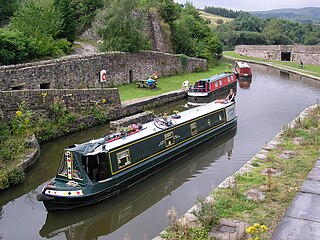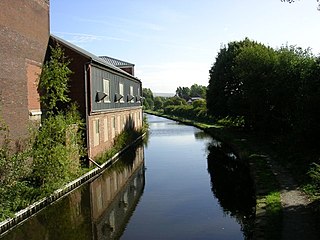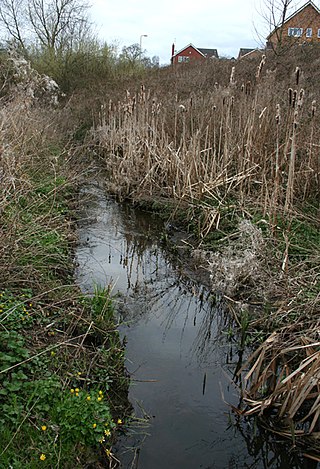The Chester Canal Heritage Trust was started in 1997, to promote the canal in Chester, Cheshire, and educate about it. The canal was originally the Chester Canal, before becoming part of the Shropshire Union Canal network.
The objectives of the trust were stated as:
The trust's objects were to advance the public education by engendering and fostering an awareness of the Chester Canal, its activities, heritage and environs, in local people and visitors by enabling people to crew heritage narrowboats; through the provision of training and education in the skills of the waterway environment; through the encouragement of exploration of the role of the waterways in the development of the surrounding area; through the support of the use and preservation of heritage narrowboats; through the development of recreational activities within the canal environment; and through the provision of a floating classroom for use by all in the North West.
The Trust was wound up in 2018.

British Waterways, often shortened to BW, was a statutory corporation wholly owned by the government of the United Kingdom. It served as the navigation authority for the majority of canals and a number of rivers and docks in England, Scotland and Wales.

A narrowboat is a particular type of canal boat, built to fit the narrow locks of the United Kingdom. The UK's canal system provided a nationwide transport network during the Industrial Revolution, but with the advent of the railways, commercial canal traffic gradually diminished and the last regular long-distance transportation of goods by canal had virtually disappeared by 1970. However, some commercial traffic continued. From the 1970s onward narrowboats were gradually being converted into permanent residences or as holiday lettings. Currently, about 8580 narrowboats are registered as 'permanent homes' on Britain's waterway system and represent a growing alternative community living on semi-permanent moorings or continuously cruising.

The Herefordshire and Gloucestershire Canal is a canal in the west of England, which ran from Hereford to Gloucester, where it linked to the River Severn. It was opened in two phases in 1798 and 1845, and closed in 1881, when the southern section was used for the course of the Ledbury and Gloucester Railway. It is the subject of an active restoration scheme.

The canal network of the United Kingdom played a vital role in the Industrial Revolution. The UK was the first country to develop a nationwide canal network which, at its peak, expanded to nearly 4,000 miles in length. The canals allowed raw materials to be transported to a place of manufacture, and finished goods to be transported to consumers, more quickly and cheaply than by a land based route. The canal network was extensive and included feats of civil engineering such as the Anderton Boat Lift, the Manchester Ship Canal, the Worsley Navigable Levels and the Pontcysyllte Aqueduct.

The Llangollen Canal is a navigable canal crossing the border between England and Wales. The waterway links Llangollen in Denbighshire, north Wales, with Hurleston in south Cheshire, via the town of Ellesmere, Shropshire. The name, which was coined in the 1980s, is a modern designation for parts of the historic Ellesmere Canal and the Llangollen navigable feeder, both of which became part of the Shropshire Union Canals in 1846.

The Pontcysyllte Aqueduct is a navigable aqueduct that carries the Llangollen Canal across the River Dee in the Vale of Llangollen in northeast Wales.

A horse-drawn boat or tow-boat is a historic boat operating on a canal, pulled by a horse walking beside the canal on a towpath.

The Ashton Canal is a canal in Greater Manchester, England, linking Manchester with Ashton-under-Lyne.

The canals of the United Kingdom are a major part of the network of inland waterways in the United Kingdom. They have a varied history, from use for irrigation and transport, through becoming the focus of the Industrial Revolution, to today's role of recreational boating. Despite a period of abandonment, today the canal system in the United Kingdom is again increasing in use, with abandoned and derelict canals being reopened, and the construction of some new routes. Canals in England and Wales are maintained by navigation authorities. The biggest navigation authorities are the Canal & River Trust and the Environment Agency, but other canals are managed by companies, local authorities or charitable trusts.

The Erewash Canal is a broad canal in Derbyshire, England. It runs just under 12 miles (19 km) and has 14 locks. The first lock at Langley Bridge is part of the Cromford Canal.

The Crick Boat Show & Waterways Festival is an event that has been held annually at Crick Marina in Northamptonshire, England, since its inception in 2000.

The National Waterways Museum (NWM) is in Ellesmere Port, Cheshire, England, at the northern end of the Shropshire Union Canal where it meets the Manchester Ship Canal. The NWM's collections and archives focus on the Britain's navigable inland waterways, including its rivers and canals, and include canal boats, traditional clothing, painted canal decorative ware and tools. It is one of several museums and attractions operated by the Canal & River Trust, the successor to The Waterways Trust.

The Kennet and Avon Canal Museum is a museum in Devizes, Wiltshire, England, covering the history of the Kennet and Avon Canal.

The Horseboating Society is a national society, with the primary aim being the preservation and promotion of Horseboating on the canals of Great Britain. The Society was founded on 19 January 2001 at the Ellesmere Port Boat Museum, and it is the only organisation in the UK solely dedicated to horseboating.
The Wooden Canal Boat Society (WCBS) is a waterway society and a registered charity in England, UK, based at Ashton-under-Lyne, Greater Manchester. The society started as the Wooden Canal Craft Trust in 1987, and by 1995 the trust owned six boats; it was wound up in 1997, and its assets were handed over to the WCBS.

The National Community Boats Association (NCBA) is a waterway society, registered charity No. 1108993 and limited company No. 5331820, in the United Kingdom.

Whitchurch Waterways Country park is an open space to the west of the Shropshire town of Whitchurch. Opened in its current form in 2002, it is a recreation area and Green corridor that takes in a town park, Greenfields Nature Reserve, Staggs Brook and the Whitchurch Arm of the Llangollen Canal. The area is maintained by Whitchurch Town Council and owned by Whitchurch Waterway Trust. There are plans to extend the canal within the country park and create a basin for Narrowboat moorings.

The Scottish Waterways Trust was an independent registered charity, established as part of The Waterways Trust in 2000. In 2012 The Waterways Trust merged its operations in England and Wales with the Canal & River Trust, and the organisation in Scotland became an independent charity.
Marsh Charitable Trust, also known as Marsh Christian Trust, is a national charity in the United Kingdom, based in London. It is a registered charity under English law, and was established in 1981 by Brian Marsh, the current Chairman. Marsh was appointed an OBE for services to business and charity in the 2005 New Year Honours.